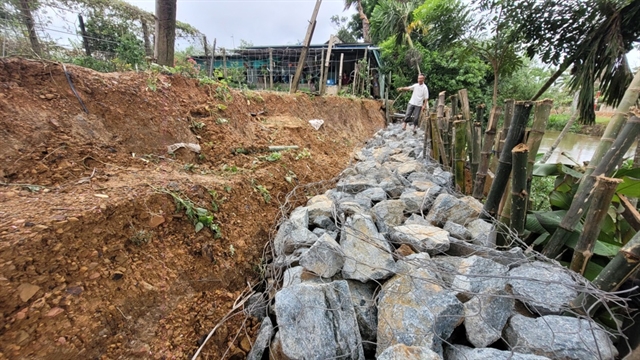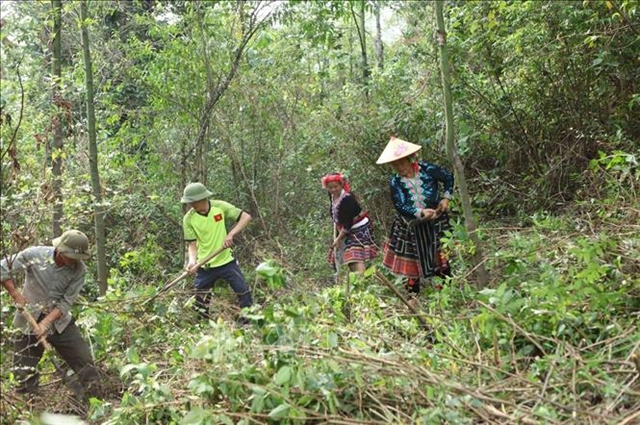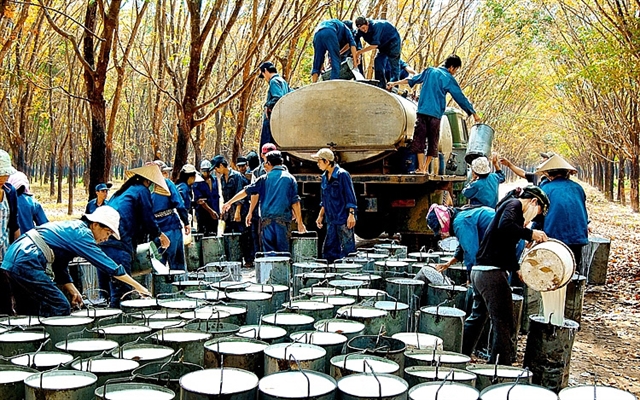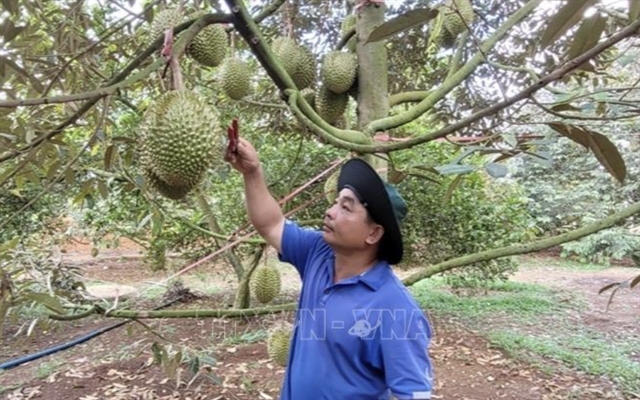 Environment
Environment

Fourty-one of the country's 63 provinces have established a forest-protection and development fund to look after nearly 6 million hectares of trees.

|
| Sin Suối Hồ villagers cut grass and other vegetation to avoid forest fires. — VNA/VNS Photo Quý Trung |
LAI CHÂU — Vàng A Chỉnh, head of the Sin Suối Hồ Village, enters the forest every day to check a forest area that he was allocated to look after in 2012 by the forest management board in Sin Suối Hồ Commune, Lai Châu Province.
The 45-year-old man from the Mông ethnic minority group works as an administrator to protect the local forest.
His village was allocated more than 600ha of forest to look after in 2012 under the forest environmental services policy.
The job brings him and other households who take part in the forest protection programme an average of VNĐ5 million (US$215) per year.
Sin Suối Hồ Village, around 30km from Lai Châu City, is home to about 135 households of Mông ethnic people.
In the first years of being allocated to protect forests, only 87 households participated in the programme. But now more than 100 households are involved, Chỉnh said.
"Forest is gold so protecting the forest is very important. People understand that only forests can retain water to serve daily life and irrigation, so local residents signed commitments to participate in forest protection and development," Chỉnh told Việt Nam News.
Forty-one of the country's 63 provinces have established a forest-protection and development fund to look after nearly 6 million hectares of trees, according to report of the Ministry of Agriculture and Rural Development.
The policy was first introduced in Việt Nam in 2008, requiring hydro-power plants, water-supply companies and environmental tourism firms using the forests to pay fees for services to provincial forest-protection and development funds.
During 2009-18, VNĐ1.5 trillion was collected from forest environment services policy in Lai Châu.
Of this, more than 60 per cent was used to pay local residents for forest protection, said Ngô Trọng Lịch, Director of Lai Châu Forest Protection and Development Fund.
The policy also helped improve living conditions, create jobs for local people, reduce poverty and eliminate social evils, Chỉnh said.
About 20 years ago, many men and some women in the village were addicted to opium.
They were often drunk and could not work after drinking, so they lived in poverty and their children were uneducated, Chỉnh said.
“I used to be illiterate and I had to work hard to change this life,” he said.
He went to other villages to learn how to do business and joined social organisations to access advanced knowledge.
From drug addiction to tourism village
In 2000, he and a number of young people in the village launched a campaign to help locals stop using drugs and alcohol.
"It was a long process with hundreds of meetings and talks with each household. Addicts gradually realised that they were a burden for their family and the community," Chỉnh said.
"They also found that they could not wipe out hunger and poverty if they did not give up drugs. So they were committed to detoxification.”
Fourteen years later, no one in the village was addicted.
In 2012, the payment policy for forest environmental services was implemented in Lai Châu, creating jobs for hundreds of local people.
Chỉnh and some people in the village had to hold many meetings and advise people to save the money they earned from forest protection to build roads and houses.
They committed to implement a 'five-no' policy: no drugs, no tobacco, no alcohol, no gambling and no littering.
They also started a travel business.
The village, located 1,500m above sea level, has a temperate and fresh climate year-round with many beautiful spots and historical relics as well as traditional wooden houses of Mông people.
Gradually, more and more tourists have chosen the village for their holidays.

|
| Sin Suối Hồ village, a famous destination, welcomes nearly 100,000 domestic and foreigners visitors each year.— VNA/VNS Photo Việt Hoàng |
Realising the potential of economic development from tourism, Chỉnh mobilised people in the village to use the money earned from forest environmental payment service to develop homestay services.
From being a poor village with men falling into addiction, the village has become a destination, welcoming nearly 100,000 domestic and foreigners visitors each year.
“The lives of the people here are getting better thanks to the policy and the forest was also managed better than before,” said Chỉnh.
Forest better managed
Nậm Nhùn District is home to 11 ethnic groups in Lai Châu, of which the Mông ethnicity make up the biggest proportion. Since the policy of payment for forest environmental services was introduced in 2011, the task of forest protection and development in the locality has become much easier.
Nguyễn Quang Hải, vice chairman of Nậm Nhùn District People's Committee, said the potential for local development was mainly found in forest land. They plan to plant an additional 113,000ha, accounting for more than 90 per cent of the natural area.
"We know the task of developing forestry land is very important and forest protection is related to water security to ensure enough water to generate electricity as well as water for daily use.
"Therefore, the district must protect watershed forests, borders and food security for people," Hải told Tin Tức (News) online newspaper.
The district has a total 75,543ha of forests with a coverage ratio of more than 54.4 per cent.
Previously, rangers faced many difficulties in forest protection, he said, adding that deforestation and forest fires occurred often.
In early 2011, the payment policy for forest protection services took effect.
In 2019 alone, Nậm Nhùn District paid people nearly VNĐ71 billion, an average of VNĐ13 million for each household.
Some households can earn VNĐ60 million a year from forest protection.
The payment policy for forest environmental services has been implemented across Lai Châu Province in 2012.
About 990 teams have been set up to protect forest in most villages and communes across the province.
Forest fires and violations of forest protection regulations tend to decrease.
Located next to Lai Châu is Sơn La Province - one of the first provinces to pilot this payment policy in 2008.
Over the past 10 years, the province has spent more than VNĐ1.16 trillion (US$50.2 million) for forest protection and development.
Sơn La has a total of 637,000ha of forest. The payment policy has helped generate stable jobs and income for local residents while encouraging them to look after the forest, according to Sòi Ngọc Dũng, director of Sơn La Forest Protection and Development Fund.
The scheme has increased financial incentives for forest protection by creating links with the beneficiaries of such services - hydro-power facilities, water supply companies, and eco-tourism operators.
The province has allocated forests for groups of households for better management, which created conditions for local residents to discuss the forest situation and mechanism-related issues.
“As a forest owner, I am the first person who is responsible for any damage to the forest in the locality. In recent years, thanks to the policy, the awareness of the Mông people on forest protection is improved. The benefits of the people have been attached to the forest protection," said Quàng Văn Hặc, chairman of Sam Kha Commune, Sốp Cộp District, and the owner of more than 6,000ha of forest.
The policy has also attracted a large number of labourers among the local people, especially in remote areas.
Every year, more than 43,000 forest owners (accounting for more than 40 per cent of the total forest owners in the country) benefit from forest environmental services and other benefits from forests. — VNS









